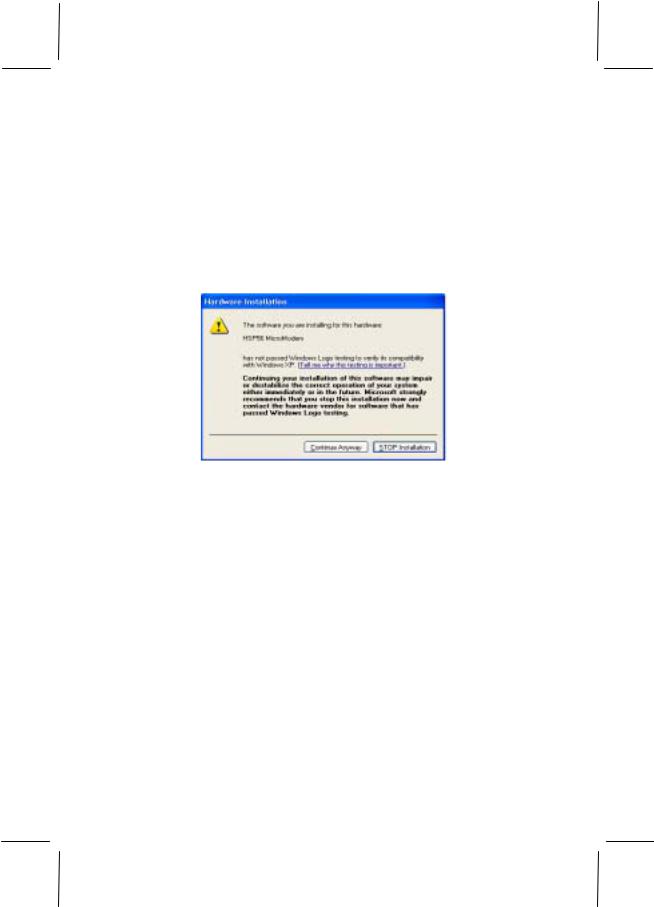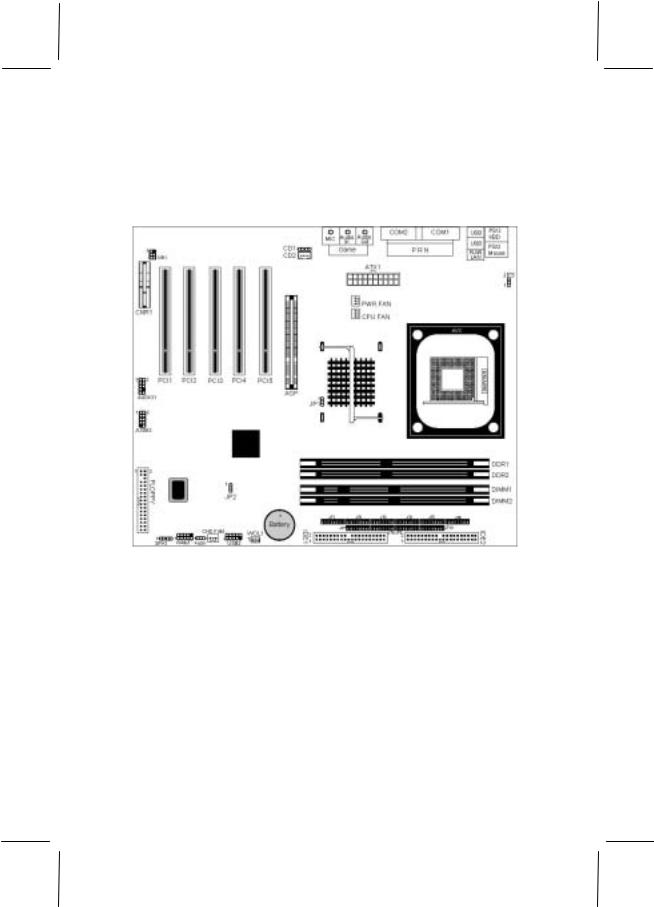Matsonic MS9047C user guide

Mainboard User’s Manual
This publication, photographs, illustrations and software are under the protection of international copyright laws and all rights reserved. It does not allow any reproduction of this manual, content and any materials contained herein without the written consent of the authentic manufacturer.
The information in this manual is subject to change without notice. The manufacturer does neither represent nor warrant the contents hereof; and specifically disclaims any implied warranties of merchantability or fitness for any particular purpose. Furthermore, the manufacturer reserves the right to revise and change this publication from time to time, without the obligation of notifying any person of such revision or changes.
Trademarks
IBM, VGA, and PS/2 are registered trademarks of International Business Machines.
Intel, Pentium/II/III, Pentium 4, Celeron and MMX are registered trademarks of Intel Corporation.
Microsoft, MS-DOS and Windows 98/ME/NT/2000/XP are registered trademarks of Microsoft Corporation.
PC-cillin is a trademark of Trend Micro Inc. AMI is a trademark of American Megatrends Inc.
MediaRing Talk is a registered trademark of MediaRing Inc. 3Deep is a registered trademark of E-Color Inc.
It has been acknowledged that all mentioned brands or product names are trademarks or registered trademarks of their respective holders.
Copyright © 2002
All Rights Reserved
MS9047C Series, V3.0
I845D/August 2002

Mainboard User’s Manual
Notice:
Owing to Microsoft’s certifying schedule is various to every supplier, we might have some drivers not certified yet by Microsoft. Therefore, it might happen under Windows XP that a dialogue box (shown as below) pop out warning you this software has not passed Windows Logo testing to verify its compatibility with Windows XP. Please rest assured that our RD department has already tested and verified these drivers. Click the “Continue Anyway” button and go ahead the installation.
II

Mainboard User’s Manual |
|
Table of Contents |
|
Chapter 1: Introduction ................................................................... |
1 |
Key Features............................................................................ |
2 |
Package Contents .................................................................... |
5 |
Static Electricity Precautions................................................... |
6 |
Pre-Installation Inspection....................................................... |
6 |
Chapter 2: Mainboard Installation................................................... |
7 |
Mainboard Components .......................................................... |
8 |
I/O Ports .................................................................................. |
9 |
Installing the Processor.......................................................... |
10 |
Installing Memory Modules .................................................. |
11 |
Jumper Settings ..................................................................... |
13 |
Install The Mainboard ........................................................... |
15 |
Optional Extension Brackets ................................................. |
16 |
Install Other Devices ............................................................. |
18 |
Expansion Slots .................................................................... |
21 |
Chapter 3: BIOS Setup Utility....................................................... |
23 |
Introduction ........................................................................... |
23 |
Running the Setup Utility...........…………………………...24 |
|
Standard CMOS Setup Page.................................................. |
25 |
Advanced Setup Page............................................................ |
26 |
Power Management Setup Page ............................................ |
29 |
PCI/Plug and Play Setup Page............................................... |
31 |
Load Optimal Settings........................................................... |
32 |
Load Best Performance Settings ........................................... |
32 |
Features Setup Page............................................................... |
33 |
CPU PnP Setup Page............................................................. |
35 |
Hardware Monitor Page ........................................................ |
36 |
Change Password .................................................................. |
37 |
Exit ........................................................................................ |
37 |
Chapter 4: About the Software CD-ROM ..................................... |
38 |
Utility Software Reference .................................................... |
39 |
III

1: Introduction
Chapter 1
Introduction
This mainboard has a Socket-478 support for Intel Pentium4 processors with front-side bus (FSB) speeds up to 533 MHz.
This mainboard has the Intel 845D chipset that contains Intel 82845 Memory Controller Hub and Intel 82801BA I/O Controller Hub. It supports AC 97 audio codec and provides Ultra DMA 33/66/100 function. This mainboard has five 32-bit PCI, one 4xAGP and one CNR (Communications and Networking Riser) slot. There is a full set of I/O ports including two PS/2 ports for mouse and keyboard, two serial ports, one parallel port, one MIDI/game port and maximum six USB ports. By means of the Extended USB Module connected to the mainboard, you can make maximum four extra USB ports.
This mainboard is an ATX mainboard that uses a 4-layer printed circuit board and measures 305 x 244mm.
1

Mainboard User’s Manual
Key Features
This mainboard has these key features:
Socket-478 Processor
♦Supports Intel Pentium 4 series CPUs
♦Supports up to 533 MHz Front-Side Bus
Memory Support
♦Two 168-pin DIMM slots for SDRAM memory modules
♦Two 184-pin DIMM slots for DDR SDRAM memory modules
♦Support SDRAM up to 133 MHz/DDR up to 266 MHz memory bus
♦Maximum installed memory is 2GB
Notice: YOU can NOT work SDRAM and DDR simultaneously.
AC 97 Audio Codec
♦The AC 97 Audio codec is compliant with the AC 97 2.2 specification, and supports 18-bit ADC (Analog Digital Converter) and DAC (Digital Analog Converter) resolution as well as 18-bit stereo full-duplex codec with independent and variable sampling rates. Further features include support for four analog line-level stereo inputs.
Expansion Options
The mainboard comes with the following expansion options:
♦Four 32-bit PCI Master slots(PCI 1~4) and one Slave slot(PCI5)
♦Supports IDE Ultra DMA bus mastering with transfer rates of 33/66/100 MB/sec
♦One 4x AGP slot only supports 1.5V 4x AGP card
♦One CNR (Communications and Networking Riser) slot
2

1: Introduction
Onboard I/O Ports
The mainboard has a full set of I/O ports and connectors:
♦Two PS/2 ports for mouse and keyboard
♦Two serial ports
♦One parallel port
♦One MIDI/game port
♦Six USB ports (two back-panel USB 2.0 ports, onboard USB headers providing maximum four extra ports: header JUSB2 for USB 2.0 and header USB2 for USB 1.1)
♦Audio jacks for microphone, line-in and line-out
Fast Ethernet LAN (Optional)
♦Built-in 10BaseT/100BaseTX Ethernet LAN
♦Integrated Fast Ethernet MAC and full compliance with IEEE 802.3u 100 Base-T specifications and IEEE 802.3x Full Duplex Flow Control
♦In compliance with ACPI 1.0 and the Network Device Class Power Management 1.0
♦High Performance achieved by 100Mbps clock generator and data recovery circuit for 100Mbps receiver
USB 2.0
♦Compliant with Universal Serial Bus Specification Revision 2.0
♦Compliant with Intel’s Enhanced Host Controller Interface Specification Revision 0.95
♦Compliant with Universal Host Controller Interface Specification Revision 1.1
♦PCI multi-function device consists of two UHCI Host Controller cores for full-/low-speed signaling and one EHCI Host Controller core for high-speed signaling
♦Root hub consists 4 downstream facing ports with integrated physical layer transceivers shared by UHCI and EHCI Host Controller
♦Support PCI-Bus Power Management Interface Specification release 1.1
♦Legacy support for all downstream facing ports
3

Mainboard User’s Manual
BIOS Firmware
This mainboard uses AMI BIOS that enables users to configure many system features including the following:
♦Power management
♦Wake-up alarms
♦CPU parameters and memory timing
♦CPU and memory timing
The firmware can also be used to set parameters for different processor clock speeds.
Bundled Software
♦PC-Cillin 2000 provides automatic virus protection under Windows 98/ME/NT/2000/XP
♦MediaRing Talk provides PC to PC or PC to Phone internet phone communication
♦3Deep delivers the precise imagery and displays accurate color in your monitor
♦Recovery Genius 21st V5.0 provides the function to recover, reserve and transfer hard disk data.
♦CD Ghost is the software stimulating a real CD-ROM to perform equivalent function.
♦Language Genius 21st is the software to provides learning tools of language and singing.
♦PC DJ is a dual-MP3 player that enables users to actually mix music right on their own personal computers.
♦Adobe Acrobat Reader V5.0 is the software to help users read .PDF files.
Dimensions
♦ ATX form factor of 305 x 244mm
4

1: Introduction
Package Contents
Attention: This mainboard serial has two models, MS9047C(533) and MS9047C+(533).
Please contact your local supplier for more information about your purchased model. Each model will support different specification listed as below:
Model
MS9047C(533)
MS9047C+(533)
Your mainboard package contains the following items:
The mainboard
The User’s Manual
One diskette drive ribbon cable
One IDE drive ribbon cable
Software support CD
Optional Accessories
You can purchase the following optional accessories for this mainboard.
Extended USB module
CNR v.90 56K Fax/Modem card
5

Mainboard User’s Manual
Static Electricity Precautions
Static electricity could damage components on this mainboard. Take the following precautions while unpacking this mainboard and installing it in a system.
1.Don’t take this mainboard and components out of their original static-proof package until you are ready to install them.
2.While installing, please wear a grounded wrist strap if possible. If you don’t have a wrist strap, discharge static electricity by touching the bare metal of the system chassis.
3.Carefully hold this mainboard by its edges. Do not touch those components unless it is absolutely necessary. Put this mainboard on the top of static-protection package with component side facing up while installing.
Pre-Installation Inspection
1.Inspect this mainboard whether there are any damages to components and connectors on the board.
2.If you suspect this mainboard has been damaged, do not connect power to the system. Contact your mainboard vendor about those damages.
6

2: Mainboard Installation
Chapter 2
Mainboard Installation
To install this mainboard in a system, please follow these instructions in this chapter:
Identify the mainboard components
Install a CPU
Install one or more system memory modules
Make sure all jumpers and switches are set correctly
Install this mainboard in a system chassis (case)
Connect any extension brackets or cables to connecting headers on the mainboard
Install other devices and make the appropriate connections to the mainboard connecting headers
Note:
1.Before installing this mainboard, make sure jumper JP2 is under Normal setting. See this chapter for information about locating JP2 and the setting options.
2.Never connect power to the system during installation; otherwise, it may damage the mainboard.
7

Mainboard User’s Manual
Mainboard Components
Identify major components on the mainboard via this diagram underneath.
Note: Any jumpers on your mainboard that do not appear in this illustration are for testing only.
8

2: Mainboard Installation
I/O Ports
The illustration below shows a side view of the built-in I/O ports on the mainboard.
PS/2 mouse
PS/2 keyboard
LAN |
Parallel port (LPT1) |
Game port |
|
|
|
|
|
port |
|
|
|
USB |
Serial port |
Serial port |
Microphone |
ports |
COM 1 |
COM 2 |
Line-in |
|
|
|
|
Line-out
1.The upper PS/2 port connects a PS/2 pointing device.
2.The lower PS/2 port connects a PS/2 keyboard.
3.The USB ports connect USB devices.
4.LPT1 connects printers or other parallel communications devices.
5.The COM ports connect serial devices such as mice or fax/modems. COM1 is identified by the system as COM1/3. COM2 is identified by the system as COM2/4.
6.The game port connects a joystick or a MIDI device.
7.Three audio ports connect audio devices. The left side jack is for a stereo line-out signal. The middle jack is for a stereo line-in signal. The right side jack is for a microphone.
8.LAN port connects the network.
9

Mainboard User’s Manual
Installing the Processor
This mainboard has a Socket 478 processor socket. When choosing a processor, consider the performance requirements of the system. Performance is based on the processor design, the clock speed and system bus frequency of the processor, and the quantity of internal cache memory and external cache memory.
CPU Installation Procedure
Follow these instructions to install the CPU:
1.Unhook the CPU socket’s locking lever by pulling it away from socket and raising it to the upright position.
2.Match the pin 1 corner of CPU socket to the one of processor, and insert the processor into the socket. Do not use force.
3.Push the locking lever down and hook it under the latch on the edge of socket.
4.Apply thermal grease to the top of the CPU.
5.Lower the CPU fan/heatsink unit onto the CPU and CPU socket, and then use the retention module clamps to snap the fan/heatsink into place.
6.Plug the CPU fan power cable into the CPU cooling fan power supply connector on the mainboard.
10
